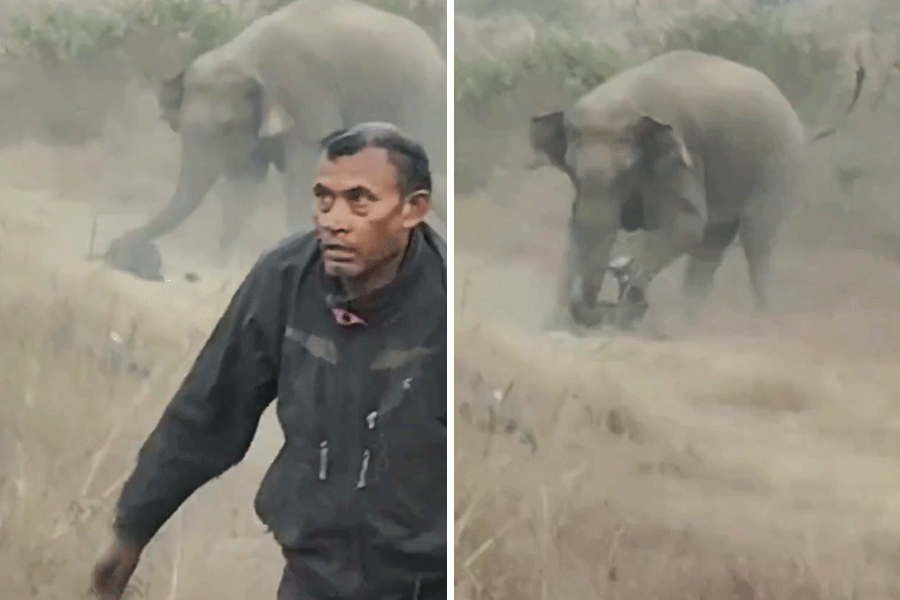 |
The book weighs 4.5 kilos. A double volume that tucks away into a glossy cardboard case. Seductive covers inviting one to explore the opulence inside.
The fruition of a two-and-a-half-year effort, the book marks 25 years in the trajectory of a brand called Abu-Sandeep. It is a “celebration of life and indulgence’’. It is also a symbol of who they are.
As is the dress form that has been distracting me all through the interview. It stands in a corner of their office room, looking much abused by time, its grey flecked with age spots. But the pinched 18-inch waist, and the generous hips and shoulders, are evocative. If I listen hard enough, I can imagine the rustle of silk, the sharp intake of breath as a flesh and blood Victorian waist struggles to emulate the proportions of the dress form.
To Abu Jani and Sandeep Khosla, it speaks of an era when opulence was inherent in the Indian way of life. When hand stitched garments were not labelled couture but were the norm; when embroidery and craftsmanship were part of everyday wear; and women walked like queens even while at their daily chores.
“It’s been 25 years since we started on this path,” says Sandeep Khosla. A quarter of a century since fate brought them face-to-face with a dream they could share. The common factor was designer Xerxes Bhatena, who had helped a reticent Bohra Muslim youth named Abu Jani, who loved to sketch, find his vocation in creating clothes, first for films and later for women who liked to experiment.
It would be to Xerxes too, that, Sandeep Khosla, the restless Kapurthala youth, would come, leaving his home in Delhi; seeking expression for his desire to work creatively with fabric and silhouette. He had tried his hand at other pursuits: leather craft as part of the family business, his own store where he sold the efforts he deployed in creating new textures on fabric with old tried and tested processes like tie-and-dye. But restless with it all, he had left it all to make the journey to Bombay.
Not surprisingly, Abu Jani and Sandeep Khosla met. The year was 1986. And they found a common creative ground that they wished to explore together. Today, the two are happy with their exclusive niche in Indian fashion, which Khosla believes “is growing by leaps and bounds... sometimes scattered, sometimes focused. But it is an exciting juncture for Indian fashion, as India is an inspiration for the world.”
Khosla has just returned from a rather triumphant launch of the book — India Fantastique — at Sotheby’s in London. Jani is still traipsing around overseas, and obviously shopping for watches, as a phone call from him to ask his partner’s opinion implies.
In a loose shirt hanging over his pants, there is little in his attire to proclaim that he is a designer of the kind of clothes the duo are known for. Jani speaks little and softly, but Khosla is quick with words and laughter and repartee — and loves the scent of hearty gossip.
“We design to please ourselves,” Khosla now stresses. “We do things that please us. Luckily though, we have found a market and we are able to have a special place in our clients’ hearts. The feedback we get is that our clothes are special, they transform the wearers.”
Indeed, transformation has been a part of their leitmotif. Twenty-two years ago, the duo decided to pool their different skills to transform the humble, almost lost craft of chikan. “When we started exploring chikan, it was done on terry voile and sold as simple office wear. The craft was close to getting lost: the stitches were often incomplete and badly finished. We decided to give chikan a new life.”
The two went to Lucknow. They looked at old blocks and used them for printing huge chaddars as dupattas, with multiple borders. “Then we started using the blocks for galas (necklines), damans (borders), using multiple blocks again for contrast. “Each block tells the story of the stitch in it; it dictates whether it should be a jali or a muree or a French knot. We followed that in the beginning but used fine fabric: silk, chiffon. Soon chikan was being teamed with diamonds and pearls and becoming a symbol of dressing for lunch.”
Today, their chikan ensembles are sported by the Bachchan family, by the Ambanis, and walk the ramp at the Oscars. “We personalised chikan,” Khosla says. “We reset the blocks, changed the stitches from how they had been read over the centuries.”
Their next step was a rung higher. Indulging their love of gold, which competes with their fondness for white, the designers revived the art of zardosi, reintroducing traditional zardosi elements. They also used silk thread to create a jamevar-inspired collection that is still popular 15 years since the designers sent out the first line.
Abu Jani sketches each design himself. Every inspiration is a black and white ink drawing that then transforms into a component of a garment. And as Khosla says, “The wonder of living and creating in India is that with three people working on a single flower, it takes just a few hours to transform an idea into reality.”
Binding the duo together is their love of travel and the search for collectibles. Khosla remembers how during their first visit to Lucknow they wandered into dark godowns in the middle of a night, led by a man with a weak torch, to look at pillars and chandeliers. It is the same story wherever they travel — be it Jaipur, Paris or London. And sometimes they come back with a “find” — the dress form, for instance, came from a flea market in London. A rare silver mask of Shiva from Chennai that now hangs in Khosla’s home is another result of rummaging in off-beat places.
When they travel, Khosla adds, food takes priority. They love to eat at places known for their food, trying out cuisines and enjoying the luxury of the ambience. Jani cooks as well as he sketches. “He can cook out of thin air,” Khosla says. “We entertain friends with his creations. But he can repeat nothing; every time a dish is different because he does not follow a recipe from any book.”
Khosla himself prefers to watch. “I love MasterChef but I enjoy Dine with Me on BBC even more,” he says, referring to popular television food series.
Also among their shared loves is the world of old films. Pakeezah, Mughal-e-Azam and Moulin Rouge are particular favourites — and it is easy to guess why. The common factor running through the films is the flamboyance and the sheer beauty of the costumes and frames. If Helen is also on that list, her costumes are surely the reason why!
It’s not surprising that their first collection, Mata Hari, had all the distinguishing marks of costume. “We had gold snakes crawling down the bust,” Khosla recalls.
The Mata Hari line piqued the curiosity of Simple Kapadia and her more celebrated sister. Jani had assisted Xerxes Bhatena during the filming of Sagar — which starred Dimple — and created the actress’s clothes for the film. So she walked in to check out his new line.
Today she is one of the duo’s most faithful clients. As is Jaya Bachchan, who has converted her entire family — possibly baby included — into Abu-Sandeep fans.
They also deeply interested in interiors — which is the theme of the second volume of the commemorative book. “It’s our way of getting time off from clothes, clothes, clothes,” Khosla says. They do one or two interiors a year, using the opportunity to indulge their love for ferreting out rare pieces.
“Everything we do is India inspired,” Khosla adds. Sometimes it works to create something new. Like the time they washed a silk kurta that had got stained, and wrung it to get all the water out. “We tied it with a string, though I don’t remember why. Then, when it was dry we opened it. And the first crushed garment met our eyes. We realised how lovely it looked and started a trend — that today is seen from Kashmir to Kanyakumari.”
Black bandhni — inspired by the widows of Gujarat who wore black and red — with long sleeves, sexy Satyam Shivam Sundaram blouses that were first sent on to stores by them, and the 48-kali kurtas that they still get requests for are other happy wanderings in Indian fashion.
That’s not bad for a team that Khosla says “disagrees about everything”. Different by nature — Abu is quiet and Khosla as “brash and loud as any Punjabi” can be, the duo have their ups and downs, and sulks and squabbles about work.
“But our deep respect for each other’s creative work keeps us one at many levels. And we have weathered 25 great years — all of which have been captured in the book. The images are global,” he says. “We ensured that with the styling and the Western models to take Indian fashion out of the ethnic bind that suggests it is costume, or down market. We want to say our clothes are couture that can be worn by anybody.”
The book — consisting mostly of photographs shot by Ram Sher Gil — will go to Paris, where, on October 4, an audience made up of Indian celebrities flying down for the event and the cream of Parisian society will witness its launch. “This book is our way of marking territory, telling the world this is all ours,” Khosla says.











